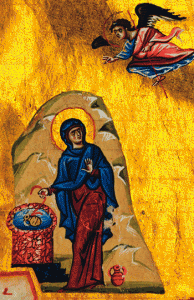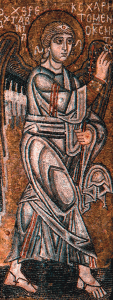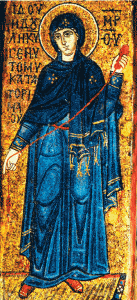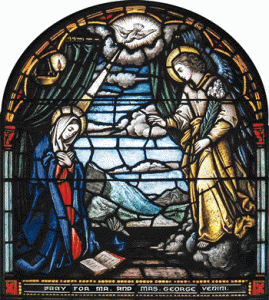Mary for Today – Mary in Culture (7) – Art and Literature

by Br Kieran Fenn fms

Mary at the well: an Annunciation scene from a Byzantine 12th century illuminated manuscript
Bibliothèque Nationale de France
Introduction
Devotion to Mary developed in the Mediterranean world. Its source lay in the gospels we have plus gospels we do not use (apocryphal) as well as other writings. Mary was presented both in art and literature in terms of the cultural perceptions of females in that world, as maid and mother. Males were ascribed market places and council halls and law courts, places where large numbers assembled for discussion and action, as their domain for times of war and peace. ‘Women were defined as best suited to the indoor life which never strays from the house, within which the middle door was taken by the maidens as their boundary, and the outer door by those who have reached full womanhood’ (Philo).
Drawing water at the well
The work of women was orientated to the sphere of the house and places where household affairs take them, such as hearths, wells and ovens. Writers and artists sensitive to these cultural norms portray the Annunciation to Mary in space appropriate to females. The Annunciation to Mary in Luke 1:26-38 did not locate the scene, except to say that it happened in ‘a city of Galilee named Nazareth.’ The earliest legendary expansion of the story created a lasting tradition that Mary was drawing water at a well when Gabriel spoke to her.
‘And she took the pitcher and went forth to draw water, and behold, a voice said: “Hail, thou art highly favoured, the Lord is with thee, blessed art thou among women.” And she looked around on the right and on the left to see whence the voice came. And trembling she went to her house and put down the pitcher and took the purple and sat down on her seat and drew out the thread.’ (Protoevangelium of James 11.1).
The legendary expansion echoes biblical stories of patriarchs meeting their future wives at wells: Isaac’s agent meets Rebekah [Genesis 24:11-21], Jacob and Rachel [Genesis 29:1-13], and Moses and Zipporah [Exodus 2:15-22]. The tradition dominated Eastern churches and there are many artistic representations of the Annunciation at the well, representing the cultural sense of the proper space of females and their proper tasks.
Weaving at home
Besides the well, both writers and artists depict the Annunciation as occurring in Mary’s house as she spun thread. The scene is appropriate, female place (house) and proper female labour (cloth production). This is in the second part of the extract from the Protoevangelium above. The legend only develops an earlier part when a young maiden, Mary, was selected to spin and weave a cloth for the Temple to cover the Holy of Holies:


Gabriel and Mary at the Annunciation; mosaics in the Hagia Sophia in Kiev, with Mary holding a skein of thread, c 1040
Thus the earliest legends about Mary’s Annunciation reflect Mediterranean cultural perceptions of females, what space and labours are appropriate to them: wells, food preparation and homes, and clothing production.
Symbolic spaces
The later church transformed the simple maiden of Galilee according to the prevailing ideas of the nobility of the Mediterranean world. Mary was no longer doing female tasks in the traditional female spaces, but acting like a cloistered nun with a vow of virginity and doing things nuns did. Cloisters served to protect female virtue by walling out worldliness and defending total dedication to God. Mary is not only cloistered but symbolically becomes a walled garden. ‘A garden locked is my sister, my bride, a garden locked, a fountain sealed …’ (Song of Songs 4:12). Even when the scene of the Annunciation occurs indoors, often there are flowers strewn on the floor to reflect the sense of a walled garden.
What should a noble virgin of that time do in her cloister? What nuns customarily were expected to do: read the Scriptures, sing the hours, and pray. One medieval writer said this of Mary:
‘The Blessed Virgin established this rule, that in the morning she prayed until the third hour, from the third to the ninth hour she was busy spinning, and from the ninth hour she again prayed continually until the appearance of the angel from whose hand she received her food. She improved so constantly in her study of the works of God that she became first in the vigils, the best informed in the law of God, the most humble in humility, the best read in the verses of David, the most gracious in charity, the purest in purity, the most perfect in all virtues.’ (Pseudo-Bonaventure. Meditations on the Life of Christ).
One can only wonder ‘What have they done to Miriam of Nazareth’?
Reference: Neyrey, Jerome H. ‘Maid and Mother in Art and Literature.’ BTB.
 Entries(RSS)
Entries(RSS)